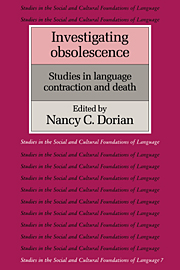Book contents
- Frontmatter
- Contents
- List of maps
- List of contributors
- Preface
- Map
- Dedication
- Introduction
- I Focus on context
- II Focus on structure
- III Invited commentaries
- 21 Some people who don't talk right: Universal and particular in child language, aphasia, and language obsolescence
- 22 Language obsolescence and language history: Matters of linearity, leveling, loss, and the like
- 23 Language convergence and language death as social processes
- 24 Pidgins, creoles, immigrant and dying languages
- 25 The “up” and “down” staircase in secondary language development
- Bibliography
- Index of languages
- General index
22 - Language obsolescence and language history: Matters of linearity, leveling, loss, and the like
Published online by Cambridge University Press: 08 January 2010
- Frontmatter
- Contents
- List of maps
- List of contributors
- Preface
- Map
- Dedication
- Introduction
- I Focus on context
- II Focus on structure
- III Invited commentaries
- 21 Some people who don't talk right: Universal and particular in child language, aphasia, and language obsolescence
- 22 Language obsolescence and language history: Matters of linearity, leveling, loss, and the like
- 23 Language convergence and language death as social processes
- 24 Pidgins, creoles, immigrant and dying languages
- 25 The “up” and “down” staircase in secondary language development
- Bibliography
- Index of languages
- General index
Summary
Thinking about language death confronts the historical linguist constantly with awkward questions concerning his fundamental concepts. All the contributors to this collection are up against these questions whether or not they say so explicitly and, for that matter, whether or not they call themselves historians. In what follows we shall discuss a few of the more explicit comments.
There was at one time a set of preconceptions into which the subject would have fitted only too well: the framework of growth and decay and ultimate death, or of evolution and ultimate extinction. Those ideas are no longer virulent. Their latency, however, is another matter. Living individuals and living species with their rather well defined physical boundaries may have proved poor sources of metaphor; but metaphor of the kind that makes a language into a corporeal object of some sort will always be with us, and so, along with its blessings, will be its pitfalls.
In retrospect – that is, to the historian – what is obsolescence? Aside from instances where speakers are killed off (“extremely rare in eastern Africa” says Dimmendaal [this volume] in one of his many intriguing asides) or, under some kind of pressure, abandon their language with a will, obsolescence occurs when a population shifts from one language to another, in ways which are open to observation (as regards the present) and to surmise (as regards the past; Campbell and Muntzel, Dimmendaal). Usually, therefore, language death is preceded by bilingualism, though, of course, bilingualism does not always presage language death. English could have died in the Middle Ages but didn't.
- Type
- Chapter
- Information
- Investigating ObsolescenceStudies in Language Contraction and Death, pp. 347 - 354Publisher: Cambridge University PressPrint publication year: 1989
- 9
- Cited by



